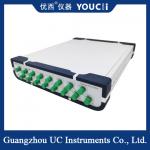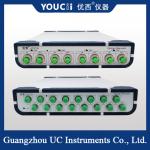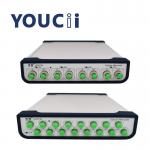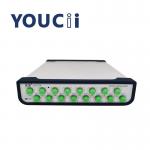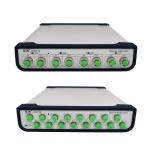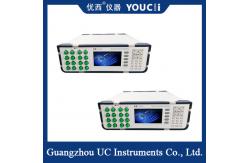Eight-Channel Multi-Mode Optical Attenuator With Display 0~35dB
Eight-channel multi-mode optical attenuator with display is an
optical attenuator with eight independent channels, each channel
can independently control the attenuation amount of optical signal.
At the same time, the device is also equipped with a display
screen, which can display the attenuation amount of the current
channel and other relevant information in real time, which is
convenient for users to monitor and adjust. In addition, it also
supports the use of multi-mode fiber, which is suitable for
different types of fiber optic communication systems.
The working principle of optical attenuator is mainly based on
light absorption, light scattering, light reflection, dislocation
technology, displacement attenuation and solid state technology. By
adjusting the parameters in these mechanisms, the amount of
attenuation of the optical signal can be controlled. In the
eight-channel multi-mode optical attenuator with display screen,
each channel is equipped with corresponding attenuation mechanism
and control circuit to achieve independent control.
Specification
| Model # | U8328S |
| Attenuator Range | 0~35 dB(40dB Type) |
| Calibration Wavelength (Option) | 850 nm (908/980 nm) |
| Insertion Loss | ≤ 1.8 dB Type 1.5dB |
| Fiber Type | 50/125um, 62.5/125um MMF |
| Connector Type | FC/UPC Connector (FC/APC ) |
| Attenuation Accuracy | ± 0.10 dB (0 ~ 30 dB) |
| Repeatability | ±0.10 dB |
| Averaging time of monitor PM | 2~1000 ms |
| Settling Time | 200ms |
| Attenuation Transition Speed | 0.1 ~ 33 dB/s |
| Return Loss | > 25 dB |
| Communication Interface | RS232, USB, RJ45 Control by PC |
| Maximum safe input power | +27dBm |
| Recalibration Period | 2 years |
| Operation Temperature | 0~ +40℃ |
| Storage Temperature | -30~+80℃ |
| Power | 100~240 V |
| Dimensions | 245mm W, 105mm H, 320 mm D |
| Weight | 5 kg
|
Eight-channel multimode optical attenuators with display screens
are widely used in optical fiber communication and optical testing.
For example, in fiber optic communication systems, it can be used
to adjust the strength of the optical signal to the dynamic range
of the receiver, thereby improving the quality of communication. In
the testing and calibration of optical fiber systems, it can also
be used to simulate optical signals of different strengths to
verify the performance of the system under different signal
strengths.

